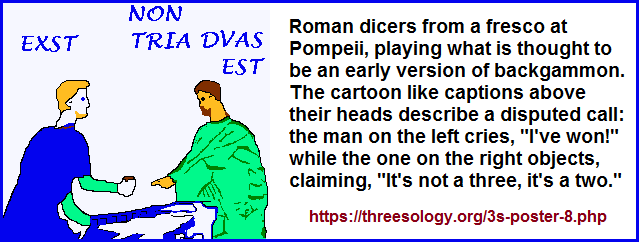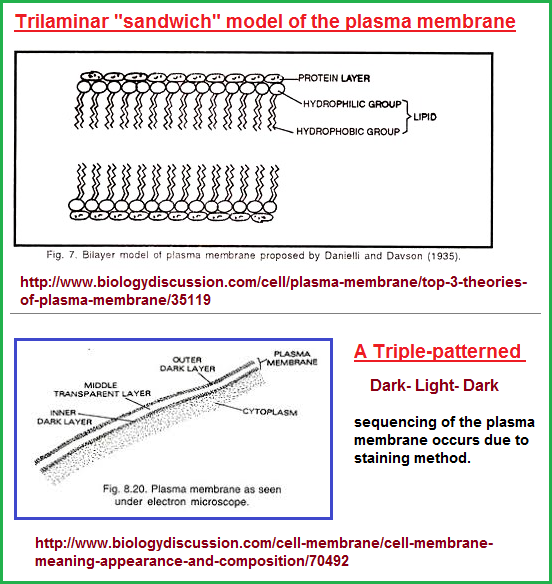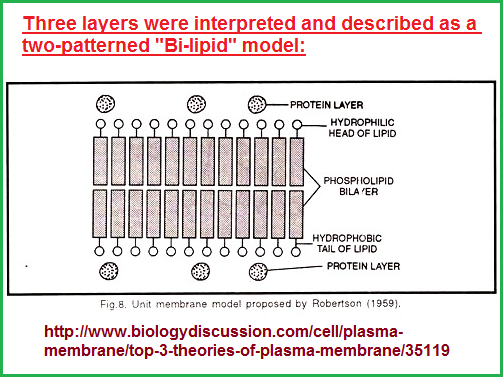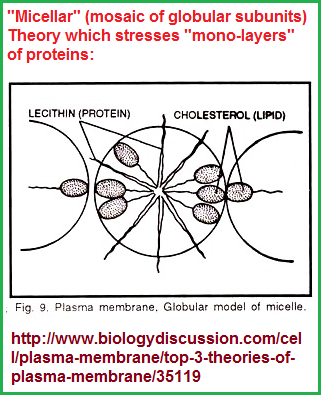~ 22 ~
~ The Study of Threes ~
http://threesology.org
Researchers as of 8/29/2019
| Devil's Advocate Series: | ||||||||
|---|---|---|---|---|---|---|---|---|
| 1 | 2 | 3 | 4 | 5 | 6 | 7 | 8 | 9 |
| 10 | 11 | 12 | 13 | 14A 14B |
15 | 16 | 17 | 18 |
| 19 | 20 | 21 | 22A 22B |
23 | 24 | 25 | 26 | 27 |
| 28 | 29 | 30 A | 30 B | 31 | 32 | 33a | 33b | 33c |
| 34 | 35 | 36 | 37 | 38 | 39 | 40 | 41 A | 41 B |
Let me return for the moment to the question of whether the plasma membrane of cells is a two-layer (bi-lipid) structure or a three-layer (trilaminar) structure, which references the 2/3 controversy discussion back on page 19 of this series in which I displayed a cartoonish image about two dice throw individuals having a disagreement about whether a particular observation was a 2 or a 3.

The image comes from column 8 of a poster I had printed up back in 1996/1997— indicating I had long ago been thinking about the 2/3 differences of opinion regarding alternative interpretations and how these two values are frequently found together.
From this article: Top 2 Types of Membrane Models (With Diagram) and its referenced Top 3 Theories of Plasma Membrane (both shared by Aastha Sharma), I have truncated the information to provide the following:
Top three theories of plasma membrane::
- Tri-Lamellar Theory (Triple-layer: Lipid/protein/lipid)
"Sandwich model" proposed by Danielli and Davson (1935), the plasma membrane exhibit trilaminar structure i.e., a lipid layer is bounded by protein layer on both the sides. In this model, proteins are usually represented in globular form. Subsequently electron microscopic studies favour the idea of trilaminar structure of plasma membrane.

- Unit Membrane Theory (Bi-lipid layer is stressed)
The universal occurrence of trilaminar pattern of membranes of cells led Robertson to propose in 1959, the concept of a ‘unit membrane’ with a trilaminar appearance. The unit membrane forms not only plasma membrane but also contains other membranes in most of the cell organelles.
All the unit membranes consist of a bimolecular layer of phospholipids covered by a layer of proteins. Phospholipid is the main part of lipid. For example, lecithin, cephalin etc. Besides it, other lipids like cholesterol, cerebroside and ganglioside as well as some polysaccharides; it is likely that these molecules provide stability to plasma lemma. Phospholipids are oriented with their fatty acid groups towards each other and their water soluble ends (polar groups) facing outwards.

- Micellar Theory (Mono-layer protein is stressed)
Hilleir and Hoffman (1963) proposed this theory. According to them the plasma membrane includes a mosaic of globular subunits (micelles) which are closely packed together having a central core of lipid molecules with hydrophilic (water loving) polar end. Each lipid micelle measures about 40-70 A in diameter. A single layer of globular protein is present on either sides of the lipid micelle. The spaces between the globular micelles represent water filled pores which measures about 4 A in diameter. The pores are bounded partly by the polar groups of protein molecules.

In the first theory a patterns-of-three is stressed. In the second theory a pattern-of-two is stressed. In the third theory a pattern-of-one is stressed. Well, what do you know... we find the human mind conceptualizing in an unrecognized one- two- three pattern. Clearly we need a whole new way of looking at the larger assortment of multiple theories in a context which invites different patterns to be grouped, and then sorted in at least one manner, by the usage of a timeline.
This will permit us not only to recognized differences in opinion, observation and illustration of different subject materials, but highlight developmental differences in an evolutionary sense respective of a given species, and that which is described by the interpretations of a human mind/brain that is assumed to be undergoing its own evolutionary changes... whether or not we describe it as being progressive. For example:
The unit membrane appears as a single trilaminar structure in plasma membrane, endoplasmic reticulum, golgi complex and lysosomes but in mitochondria, plastids and nuclei, the boundaries have an outer and an inner membrane, each with unit membrane structural plan: Top 2 Types of Membrane Models (With Diagram)
In other words, let us itemize the lists into their respective enumeration:
- Trilaminar structure in plasma membrane, endoplasmic reticulum, golgi complex and lysosomes.
- Bi-membrane structure in mitochondria, plastids and nuclei.
Either there is a 2 and 3 difference or we humans are misinterpreting the structures due to our "Baconian Idols" (highlighted on the previous page). Assuming that there actually is a difference, we can then assume to account for the difference by way of a "threesological" 1-2-3... maturational development sequence which suggests that those biological entities with a "two" structure either came before those with a three-structure, or are immature (juvenile) models of some three part entity "in development", or expressing an "arrested development". Unless of course a third option is to be supposed. Nonetheless, an ability to view multiple patterns in a singular biological context of development over time is provided by adopting a "threesological" orientation.
Let us say that we look at all biological ideas with an emphasis of highlighting the underlying enumeration. Despite an inclination to suggest they merely represent different models of perception that the human mind configures into a given pattern, we can assume that in most... or many cases, that which is being expressed as a pattern is the actual pattern of a given subject under study. The fact that we can see patterns of enumeration with low number values cropping up again and again suggests that this is because this is a recurring "law" of biological development to repeat low values, or that the human mind is for one reason or another obsessed with doing so. This presumed "obsession" has to arise from somewhere. If it is not due to the quality of the material being studied, then human physiology is directed to do so... perhaps because of an ongoing and observable environmental influence. In other words, we keep seeing patterns-of-1,2,3... because our perceptions are being forced to accommodate an environmental circumstance aligned with the incrementally deteriorations of the planet and solar system.
If the patterns being recognized in biology actually exist as we humans are describing them, then something is making the same low number patterns arise again and again. There is no evolutionary processes of the overall processes. They still follow the same one-two-three evolutionary trend and are therefore not subject to the same influence(s) as biology itself. Like the triplet code retaining its character as a triplet code and not itself evolving. It is rather strange to recognize something that is repeatedly occurring with biology and seemingly not subject to its same developmental sequencing that biological events are.
In voicing ad avocation for the "three", some readers may react negatively and want to point out examples of an other-than-three occurrence. Such examples are welcomed because this will provide knowledge as to how frequent or infrequent their preference occurs. It will also help to highlight that there actually exists a small quantity of low value number patterns and that there are a few, more than others, which repeat most often. The low overall quantity and quality of number patterns suggests something is forcing the repetition instead of allowing growth to be exponential, as suggested by the multiplicity of cell development. Indeed, we do not see a multiplicity of eyes, ears, noses, brains, hearts, etc... Nor do we see a multiplicity of ideas. There is a constraint. A constraint that may be tied to a requirement of equilibrium in an incrementally deteriorating environment humanity is being forced to remain in... like the organelles of a cell not being able to exceed their environment to grow independently instead of retaining the same type of symbiosis.
If the constraint is due to something in the environment or perhaps the whole of the environment, and something occurs to alter the environment from a source with a type that is not conventionally thought of (such as not being related to a change in water, oxygen or sunlight), humanity should come to understand what this is as a type of preparation and knowledge of how it might be possible to alter the environment to stir evolutionary development along a directed course.
Indeed, highlighting enumerated patterns helps to identify how wide-spread the occurrence of non-evolving occasions there are occurring with different biological structures. We need to develop a means to gain a larger grasp of the whole of biological mechanisms from every single nook and cranny of study. If we spot an instance of a pattern which exceeds the "three", let us note how often and wide-spread it is, and also where it is not. Is it to be interpreted as an anomaly, or as a specificity to a given biological circumstance? For example, yes we see five fingers and five toes, but we don't see five ears, five testicles, five breasts, five chins, five tails, five horns, etc... The presence of an other-than-three pattern does not discount the three, but highlights its frequency and the lack of the same in other number patterns. It also shows that the five does not evolve into a fifty or five hundred or.... some larger number variation. The five, like the three, like the two, like the four, etc., are all expressions of a conservation... of what might be viewed as an enforced formula of adaptation that appears to be similarly expressed in the small-mindedness of human imagination, despite the human ego's attempts to say otherwise.
When we speak of environmental pressures on biology, we don't necessarily ascribe this to psychology with respect to thinking and imagination. Because there is an observable constraint in force, so too should we see this in the lack of evolved ideas and imagination. There is a recurring constraint typified into the idea of "common" sense and "common" knowledge and a host of other references speaking about the constraint, but this is being overlooked by some stupid notion of normalcy, though even talent, creativity and genius art themselves expressions of the constraint but full humans into thinking otherwise... that they have some presumed ability to be more than the customary human, but without recognizing talent, creativity and genius as having a constrained commonness themselves. Metaphorically, if a genius is described as a "3" and the talented as well as gifted and creative are seen as either a "2" or transitions between a 2 and a 3 when compared to a commonness labeled a "1", the 1-2-3 sequencing is a commonness of the species and does not actually express a presumed evolutionary progressiveness for the whole of the species, though those interpreted as being greater than the common person suggest that humanity has a great potential that it has not yet fully tapped into. However, the problem remains with how we are interpreting what is meant by talent, creativity, giftedness, and genius. An average person born today into a social circumstance of idiots may be viewed as a genius and interpreted as something that humanity can and perhaps will evolve into, but this perception of the human condition is based on egotism and not what is actual.
The same goes for the many interpretation humanity is making about various biological life form developments. While we may interpret the early → to → later developments as expressions of evolutionary development generally termed as progressiveness, this may not actually be the case. It may be little more than another variation of the same low number expressions which are repeating, where compoundings of simple structures is labeled a complexity and that complexity is frequently interpreted to mean an evolutionary advancement; Yet we have failed to catalog them in order to gain a comprehensive perspective of all of biology, We customarily take isolated examples as a reference to the whole as a generality that is interpreted to mean specificity for the whole system of life. We have not had a model which would provide us with a perspective that provides an attempted handle to grasp the entire spectrum of all of biology from atomic structure to developmental complexity in its multi-various forms. However, a threesological approach is a step in this direction.
While I am using the words "constraint" and "conservation" inter-changeably, others may be thinking in terms of longevity. Here is a chart giving examples of relative limits for different animals, though we should include atomic nuclei, molecules, galaxies, etc., in a more comprehensive list, which involves providing a list of short-lived examples as well. While I mention such additions, the only addition that I have placed in the chart is that of the human man and woman taken from this article: This is the oldest age you can possible live (according to science) by Ari Notis 2/1/2019. [H.O.B: Exceptions to the listed maximums may occur, but there is no guarantee that these 'anomalies' can be turned into a widespread application for any given species.}
With respect to atomic nuclei: (typically measured in a half-life, stable atoms have a limit imposed by the lifetime of proton (>1025 years). Remember, though, that the best estimate of the present age of the universe is the much smaller number of 1010 years, so for all practical (limited life span human) purposes, atoms are forever.: How long is the lifespan of an atom? by Jefferson Lab.
With respect to DNA: Last year, researchers estimated that the half-life of DNA — the point at which half the bonds in a DNA molecule backbone would be broken — is 521 years. That means that, under ideal conditions, DNA would last about 6.8 million years, after which all the bonds would be broken. But DNA would not be readable after about 1.5 million years, the researchers said. Boston Strangler Case: How Long Does DNA Last? by Rachael Rettner, July 12, 2013
Another perspective of looking at the limited time in which DNA is viable is to view this in a mirror-image way. In a word, this suggests that time itself has a limited viability, thus rendering the notion of time travel into considerations that it disintegrates over time... which is... over itself. We would not then be able to go back into time without encountering moments of disintegration as well as a consideration that time itself changes the future, just as some fear that going back into time and making a change would disrupt the assumed timeline of the future... that is, our present and beyond. The disintegration of time interferes with its later extrapolations. Hence, perceived anomalies like deja vu are a ripple in time— where "ripples" can be variously experienced but most often dismisses as a vagary of some pollutant such as being tired, malnourished, stressed, etc... If time and DNA are closely linked within the closed Earth environment due to some sort of unrecognized symbiotic relationship which can occur... and different types of symbiotic relationships can occur with time because its viability is dependent on anything in existence and it too, like DNA, creates various types of species-dependencies for its existence. Hence, time does not need a biologically based life form to symbios with, since it can attach to anything... like atoms, or even itself.
With respect to longevity, it appears that, generally speaking, some animals live longer in captivity. While one may argue they get a steady diet, are removed from various predations, the fact remains they are in captivity. This may account for the rise in the longevity of humans. They are in an increasing state of various captivities: various medical interventions (immunization, antibiotics, dentistry, childbirth, etc...); nutritional consistencies of daily requirements (vitamins, minerals, proteins, fats, carbohydrates); food (additives, preservatives, processing), water (treated, bottled); hygiene, sanitation; government/political restraints (laws, procedures, time constraints, etc...); religion (ceremonialisms and moralistic observances breed consistency of constraints; business (consistency of manufacturing, commercialism); employment requirements; single-mindedness (such as nationalism, team orientation, industry orientation, career selectivity, institutional orientation, sexual orientation, sport/entertainment orientation, etc...); incarceration, military service, militant-styled security services (CIA, FBI, US Marshals, police/fire departments, National guards, Homeland security, Secret Service, NSA, border patrol, Coast guard, etc...). Whether known as pets, as indentured servants, by social class, by race, gender, age, education, language, etc., all of these and many other labels describe different forms of captivity which can assist or hinder longevity.
| Mammals (4-chambered heart) | |
| Animal | Life span in years |
| Human Male/Female | 114.1/115.7 years |
| Elephant | 70 years |
| Camel | 50 years |
| Donkey | 45 years |
| Horse | 40 years |
| Lion | 35 years |
| Deer | 35 years |
| Bull | 28 years |
| Pig, wild | 25 years |
| Cat | 23 years |
| Tiger | 22 years |
| Cow | 22 years |
| Ox | 20 years |
| Wolf | 18 years |
| Dog, small | 17 years |
| Sheep | 15 years |
| Goat | 15 years |
| Fox | 14 years |
| Dog, large | 12 years |
| Rabbit | 9 years |
| Mouse | 4 years |
| Birds (2-chambered hearts) | |
| Animal | Life span in years |
| Amazon Parrot | 80 years |
| Macaw | 50 years |
| Pigeon | 26 years |
| Blackbird | 18 years |
| Chicken | 15 years |
| Reptiles(3-chambered hearts) | |
| Animal | Life span in years |
| Galapagos Land Tortoise | 193 years |
| American Box Turtle (3-chambered heart, but turtles exhibit the precursor stage into a 4-chamber heart ) | 123 years |
| Crocodile (The only reptile with a 4-chambered heart) | 45 years |
| Rattlesnake | 22 years |
| Insects (multiple "chambered" heart) | |
| Life Form | Life span in years |
| Ant, queen | 3 years |
| Ant, worker | 0.5 year |
| Bee, queen | 5 years |
| Bee, worker | 1 year |
Let me provide two examples of life forms which sometimes bring to mind thoughts of evolutionary overlap or transitional stages that either have occurred which we can not recognize or that there are no extent living forms left to make a clear comparison for (in terms of being a stage in the development of life forms we recognize today instead of having developed their own extinct lines of descent):
- Sponge
- Although most of the approximately 5,000–10,000 known species of sponges feed on bacteria and other microscopic food in the water, some host photosynthesizing microorganisms as endosymbionts, and these alliances often produce more food and oxygen than they consume. A few species of sponges that live in food-poor environments have evolved as carnivores that prey mainly on small crustaceans.
- Sponges in temperate regions live for at most a few years, but some tropical species and perhaps some deep-ocean ones may live for 200 years or more. Some calcified demosponges grow by only 0.2 mm (0.0079 in) per year and, if that rate is constant, specimens 1 m (3.3 ft) wide must be about 5,000 years old. Some sponges start sexual reproduction when only a few weeks old, while others wait until they are several years old.
- Venus Fly Trap
- Like all plants, the Venus flytrap gets its energy from the sun in a process called photosynthesis. To supplement its diet to get nutrients it cannot get from the soil, the plant eats ants, beetles, grasshoppers, flying insects, and spiders are all victims of the flytrap. It can take a Venus flytrap three to five days to digest an organism, and it may go months between meals.
- Each trap on the plant can only open and close several times before it dies and falls off. Then the plant produces a new trap from its underground stems. The lifespan of the Venus flytrap isn’t known for certain, but it’s been estimated to live up to 20 years and possibly longer.
The Wild World of Carnivorous Plants by Kenny Coogan
Origination date: Tuesday, September 24th, 2019... 5:07 AM
Initial Posting: (Deming, NM) Wednesday, September 25th, 2019... 8:18 AM
Updated Posting:Tuesday, January 17th, 2023... 12:39 AM
Herb O. Buckland
herbobuckland@hotmail.com